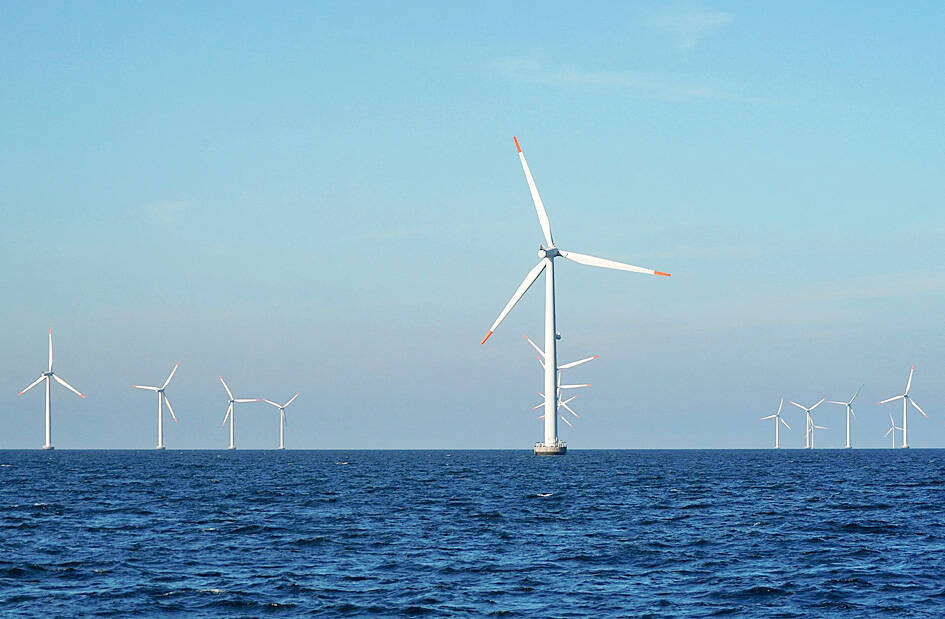Equinor ASA acquired a US$2.5 billion stake in Danish wind energy giant Orsted A/S, pairing one of the Nordic region’s biggest fossil fuel companies with its largest renewable power developer.
The deal with Equinor marks one of the most prominent endorsements of the beleaguered offshore wind industry in years, just as falling interest rates and easing supply chain bottlenecks brighten the outlook for renewable technology key to Europe’s climate goals.
The transaction comes at a critical time for the giant wind developer as Orsted chief executive officer Mads Nipper tries to execute a turnaround plan after the company recorded billions of dollars of write-downs last year due to troubles with offshore wind farms in the US.

Photo: Tom Little, Reuters
“The offshore wind industry is currently facing a set of challenges, but we remain confident in the long-term outlook for the sector, and the crucial role offshore wind will play in the energy transition,” Equinor chief executive officer Anders Opedal said in a statement.
The deal gives Equinor a nearly 10 percent stake in Orsted, making it the second largest shareholder after the Danish government, according to a statement. Equinor doesn’t intend to increase its shareholding any further for now, won’t seek board seats and says it’s supportive of Orsted’s strategy and management.
For Equinor, it’s a simple way to boost its renewable power portfolio. The company has a target of 12 to 16 gigawatts of green power capacity by 2030.
“Equinor gets access to net 1 gigawatt in operating assets for US$2.5 billion, which is similar to the cost of building offshore wind projects – without the risk on construction and delivery, as well as supply chains,” RBC Europe Ltd energy research head Biraj Borkhataria said.
Orsted is trying to claw its way back to growth. Shares soared during the COVID-19 pandemic as rock-bottom interest rates and a frenzy of green investing pushed its market value to nearly US$94 billion in early 2021, just as Nipper took over as CEO. When borrowing costs soared, projects that Orsted was planning to develop looked more expensive forcing the company to write down and exit several sites in the US.
The company canceled two major American projects and fired top executives. Investors fled, sending the company’s shares down so low that Orsted was at one point worth less than the sum of its operating wind farms.
Nipper responded in February with a turnaround plan that axed the company’s dividend, laid off staff and cut its plans to grow this decade. The company has gradually regained value this year, though it’s still worth far less than before the crisis last year.

Anna Bhobho, a 31-year-old housewife from rural Zimbabwe, was once a silent observer in her home, excluded from financial and family decisionmaking in the deeply patriarchal society. Today, she is a driver of change in her village, thanks to an electric tricycle she owns. In many parts of rural sub-Saharan Africa, women have long been excluded from mainstream economic activities such as operating public transportation. However, three-wheelers powered by green energy are reversing that trend, offering financial opportunities and a newfound sense of importance. “My husband now looks up to me to take care of a large chunk of expenses,

SECTOR LEADER: TSMC can increase capacity by as much as 20 percent or more in the advanced node part of the foundry market by 2030, an analyst said Taiwan Semiconductor Manufacturing Co (TSMC, 台積電) is expected to lead its peers in the advanced 2-nanometer process technology, despite competition from Samsung Electronics Co and Intel Corp, TrendForce Corp analyst Joanne Chiao (喬安) said. TSMC’s sophisticated products and its large production scale are expected to allow the company to continue dominating the global 2-nanometer process market this year, Chiao said. The world’s largest contract chipmaker is scheduled to begin mass production of chips made on the 2-nanometer process in its Hsinchu fab in the second half of this year. It would also hold a ceremony on Monday next week to

TECH CLUSTER: The US company’s new office is in the Shalun Smart Green Energy Science City, a new AI industry base and cybersecurity hub in southern Taiwan US chip designer Advanced Micro Devices Inc (AMD) yesterday launched an office in Tainan’s Gueiren District (歸仁), marking a significant milestone in the development of southern Taiwan’s artificial intelligence (AI) industry, the Tainan City Government said in a statement. AMD Taiwan general manager Vincent Chern (陳民皓) presided over the opening ceremony for the company’s new office at the Shalun Smart Green Energy Science City (沙崙智慧綠能科學城), a new AI industry base and cybersecurity hub in southern Taiwan. Facilities in the new office include an information processing center, and a research and development (R&D) center, the Tainan Economic Development Bureau said. The Ministry

State-run CPC Corp, Taiwan (CPC, 台灣中油) yesterday signed a letter of intent with Alaska Gasline Development Corp (AGDC), expressing an interest to buy liquefied natural gas (LNG) and invest in the latter’s Alaska LNG project, the Ministry of Economic Affairs said in a statement. Under the agreement, CPC is to participate in the project’s upstream gas investment to secure stable energy resources for Taiwan, the ministry said. The Alaska LNG project is jointly promoted by AGDC and major developer Glenfarne Group LLC, as Alaska plans to export up to 20 million tonnes of LNG annually from 2031. It involves constructing an 1,290km